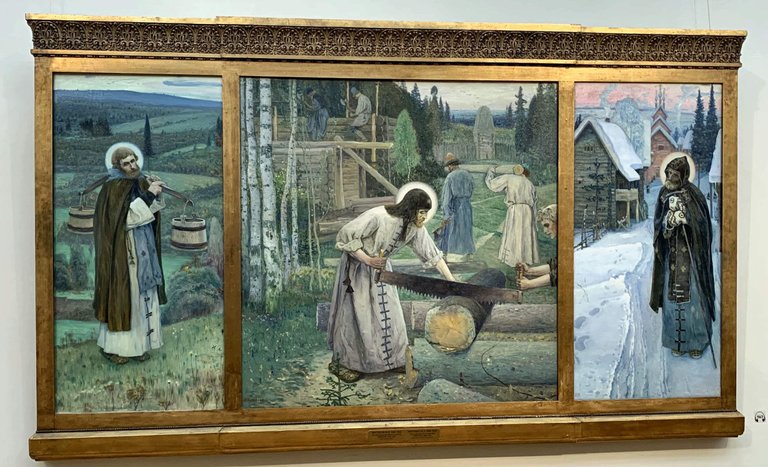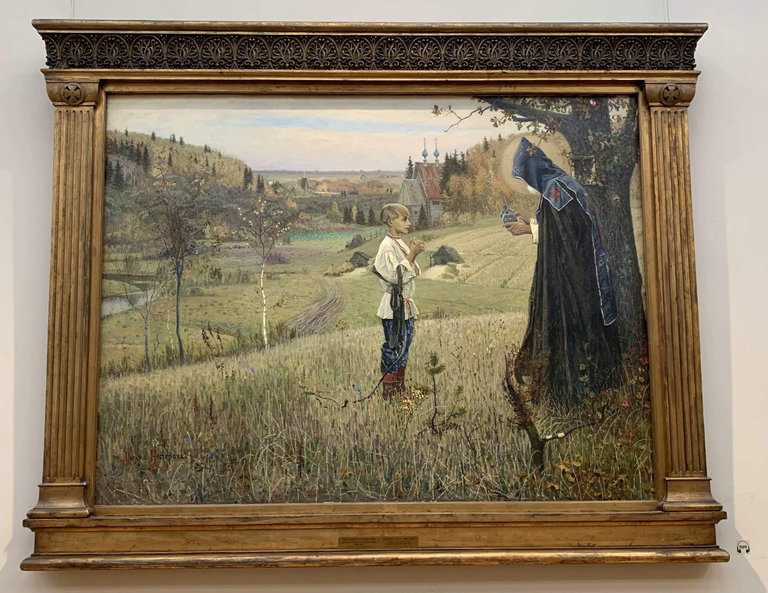Nesterov Mikhail Vasilyevich. Russian Soviet artist, painter, member Of the Association of traveling exhibitions and "World of art". Academician of painting. Honored artist of the RSFSR. Winner of the Stalin prize of the first degree.
Нестеров Михаил Васильевич. Русский советский художник, живописец, участник Товарищества передвижных выставок и «Мира искусства». Академик живописи. Заслуженный деятель искусств РСФСР. Лауреат Сталинской премии первой степени.
The creativity of this artist passed me by. I knew absolutely nothing about him until the day I saw his work in the Tretyakov gallery. I can't even say why it happened.
His many works before 1917 were connected with religion, with his search for the Russian soul.
In 1889-1990 he painted a picture "Vision to the lad Bartholomew" on a plot taken from the "Life of St. Sergius" by Epiphanius the Wise. The image of this Saint was close and dear to Mikhail Vasilyevich, it was for him the ideal of morality.
This picture caused conflicting opinions of critics and experts of the time. It became a sensation of the XVIII Traveling exhibition and was acquired by P.M.Tretyakov in his gallery. Until the end of his days, the artist was convinced that this is the best of his creation.
Творчество этого художника прошло мимо меня. Я совершенно ничего не знал о нём до того дня, как увидел его работы в Третьяковской галлерее. Даже не могу сказать почему это так произошло.
Его многие работы до 1917 года были связаны с религией, с его поисками русской души.
В 1889-1990 годах он написал картину «Видение отроку Варфоломею» на сюжет, взятый из «Жития преподобного Сергия» авторства Епифания Премудрого. Образ этого святого был близок и дорог Михаилу Васильевичу, он был для него едеалом нравственности.
Эта картина вызвала противоречивые мнения критиков и экспертов тех времен. Она стала сенсацией XVIII Передвижной выставки и была приобретена П.М.Третьяковым в свою галерею. До конца своих дней художник был убеждён в том, что это самое лучшее его произведение.
Nesterov wrote a series of paintings dedicated to St. Sergius Radonezhsky and the beginning was the painting "Vision". All such works were written before 1917, before the Revolution in Russia.
Нестеров написал целый цикл картин, посвящённых святому Сергию Радонежскому, а началом была картина "Видение". Все подобные произведения были написано до 1917 года, до Революции в России.
Painting "The Youth of St. Sergius Radonezhskу". Картина "Юность преподобного Сергия Радонежского"

The Picture "Proceedings Of St. Sergius Radonezhsky". Картина "Труды Преподобного Сергия Радонежского"

In 1914-1916, Mikhail Vasilyevich painted "The Soul of the people", which he originally called "Christians" and "In Russia".
In this work embodied the artist's long thoughts about the fate of the Motherland and the Russian people.
The picture depicts a collective image of the Russian people-walking along the banks of the Volga procession of people seeking God and truth, and far ahead of this diverse crowd steps a peasant boy of twelve years, written by Nesterov from the son of Alyosha — according to the author's plan the perfect expression of the soul of the people.
Nesterov considered "The Soul of the people" one of the most important of his works and repeatedly repeated: «At the beginning of life — "The Lad Bartholomew", by the end — "The Soul of the people"».
В 1914-1916 годах Михаил Васильевич пишет картину «Душа народа», которые первоначально называл «Христиане» и «На Руси».
В этом произведении воплотились долголетние раздумья художника о судьбе родины и русского народа.
На картине изображён собирательный образ русского народа — идущее вдоль берега Волги шествие ищущих Бога и правды людей, а далеко впереди этой разнообразной толпы ступает крестьянский мальчик лет двенадцати, написанный Нестеровым с сына Алёши — по замыслу автора совершеннейшее выражение души народа.
Нестеров считал «Душу народа» одним из наиболее значимых своих произведений и неоднократно повторял: «В начале жизни — „Отрок Варфоломей“, к концу — „Душа народа“».

And then it was 1917. And the writing of such paintings was banned. Nesterov began to paint portraits. But this was a completely different work of this artist.
For the portrait of academician Vavilov, which he painted in 1935, in 1941 he was awarded the Stalinsky Prize of the 1st degree.
А дальше был 1917 год. И написание таких картин стало под запретом. Нестеров сталписать портреты. Но это уже было совсем другое творчество этого художника.
За портрет академика Вавилова, который он написал в 1935 году, в 1941 году его наградили Сталинской Премией 1 степени.
I want to say that all these paintings need to be seen firsthand. To realize their size, to feel the power emanating from the paintings.
I will also try to prepare a video recorded during a visit to the gallery, I wanted to convey the very atmosphere of the halls, the sounds from the people who walk through these halls.
Хочу еще сказать, что все эти полотна нужно видеть воочию. Осознать их размер, почувствовать силу, исходящуюю от картин.
Я также постараюсь подготовить видео, записанное во время посещения галереи, я хотел передать саму атмосферу залов, звуки от людей, которые ходят по этим залам.
To be continued... Продолжение следует...
Thanks for reading...
Follow Me For Daily Posts!
Good luck and have fun

Thanks for using eSteem!
Your post has been voted as a part of eSteem encouragement program. Keep up the good work! Install Android, iOS Mobile app or Windows, Mac, Linux Surfer app, if you haven't already!
Learn more: https://esteem.app
Join our discord: https://discord.gg/8eHupPq
Третье полотно любо, доброе))
Да там они все «любо». И дорого. 😂
Posted using Partiko iOS
))))